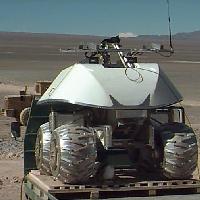In June and July of 1997, a four year program to develop technologies for space exploration culminated in the Atacama Desert Trek. The robot Nomad, supervised via satellite from thousands of miles away, attempted to traverse the Atacama desert while acquiring various forms of geological data. The command center was at the Carnegie Science Center in Pittsburgh, PA, and Nomad’s onboard sensors and intelligence allowed it to be operated by the general public.
For the foreseeable future, our explorers to other worlds will be robots. Many questions about controlling robotic explorers, communicating with them over vast distances, and how well they will survive long duration treks and harsh condition, are currently unanswered. Funded by NASA, the Atacama Desert Trek broke new ground in the areas of robotic communication and imagery. Innovative precision pointing of Nomad’s antenna to a satellite relay station provided data rates much greater than those previously attainable from a moving platform. With this bandwidth the robot delivered live 360?panoramic imagery of its surroundings. This imagery was displayed live on a 10 foot high, 35 foot wide projection screen at the ElectricHorizon theatre in the Science Center.
In the Atacama desert, Nomad traversed harsh terrain analogous to that found on the Moon and planets. The robot’s four wheel drive/four wheel steering locomotion and innovative suspension system provided effective traction, mobility, and propulsion across loose sands, rocks and soils typical of the Atacama landscape. Unique to Nomad, the chassis expands, increasing the wheel base and track for improved stability over rugged terrain. Nomad also has a visual guidance system that calculates the robot’s location by tracking landmarks on the skyline. During periods of lost or degraded communications, Nomad used its onboard avigation sensors to continue its mission, choosing its own path until communications were reestablished.
The Atacama Desert Trek moved high performance robotic technologies out of the laboratory and toward space. Beyond its technical objectives, the Atacama Desert Trek set new standards of public involvement and educational outreach. With capabilities forged in the desert, Nomad served as the precursor to robotic explorers destined for other worlds.
current head
current staff
current contact
past staff
- Anthony Nolla
- Chris Williams





